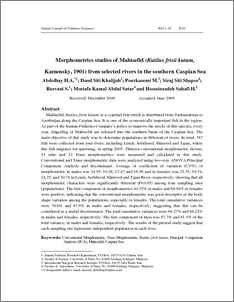Citation
Abdolhay, Hossein A. and Daud, Siti Khalijah and Pourkazemi, M. and Siraj, Siti Shapor and Rezvani, S. and Abdul Satar, Mostafa Kamal and Hosseinzadeh Sahafi, H.
(2010)
Morphometrics Studies of Mahisefid (Rutilus frisii kutum, Kamensky, 1901) from Selected Rivers in the Southern Caspian Sea.
Iranian Journal of Fisheries Sciences, 9 (1).
pp. 1-18.
ISSN 1562-2916
Abstract
Mahisefid, Rutilus frisii kutum , is a cyprinid fish which is distributed from Turkmenistan to Azerbaijan along the Caspian Sea. It is one of the economically important fish in the region. As part of the Iranian Fisheries Company’s policy to improve the stocks of this species, every year, fingerling of Mahisefid are released into the southern basin of the Caspian Sea. The main objective of this study was to determine populations in different of rivers. In total, 387 fish were collected from four rivers, including Lemir, Sefidrood, Shirrood and Tajan, where this fish migrates for spawning, in spring 2005. Thirteen conventional morphometric factors, 13 ratio and 12 Truss morphometrics were measured and calculated in this study. Conventional and Truss morphometric data were analyzed using two-way ANOVA Principal Component Analysis and discriminant. Average of coefficient of variation (CV%) of morphometric in males was 14.95, 10.28, 17.47 and 16.56 and in females was 21.35, 19.74, 18.25, and 19.74 in Lemir, Sefidrood, Shirrood and Tajan River, respectively, showing that all morphometric characters were significantly different (P<0.05) among four sampling sites (populations). The first component of morphometrics 44.32% in males and 68.94% in females were positive, indicating that the conventional morphometric was good descriptor of the body shape variation among the populations, especially in females. The total cumulative variances were 76.6% and 87.8% in males and females, respectively, suggesting that this can be considered as a useful discriminator. The total cumulative variances were 64.27% and 64.21% in males and females, respectively. The first component of truss was 87.7% and 81.3% of the total variance, in males and females, respectively. The results of the present study suggest that each sampling site represents independent population in each river.
Download File
![[img]](http://psasir.upm.edu.my/style/images/fileicons/application_pdf.png)  Preview |
|
PDF
Morphometrics_studies_of_Mahisefid.pdf
- Submitted Version
Download (405kB)
|
|
Additional Metadata
Actions (login required)
 |
View Item |

